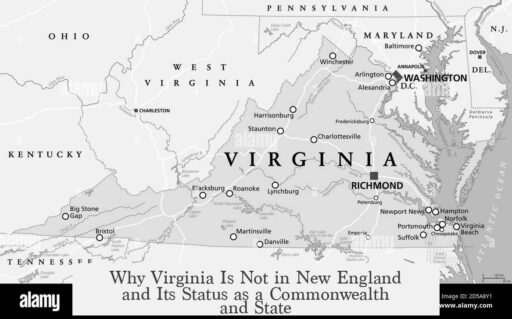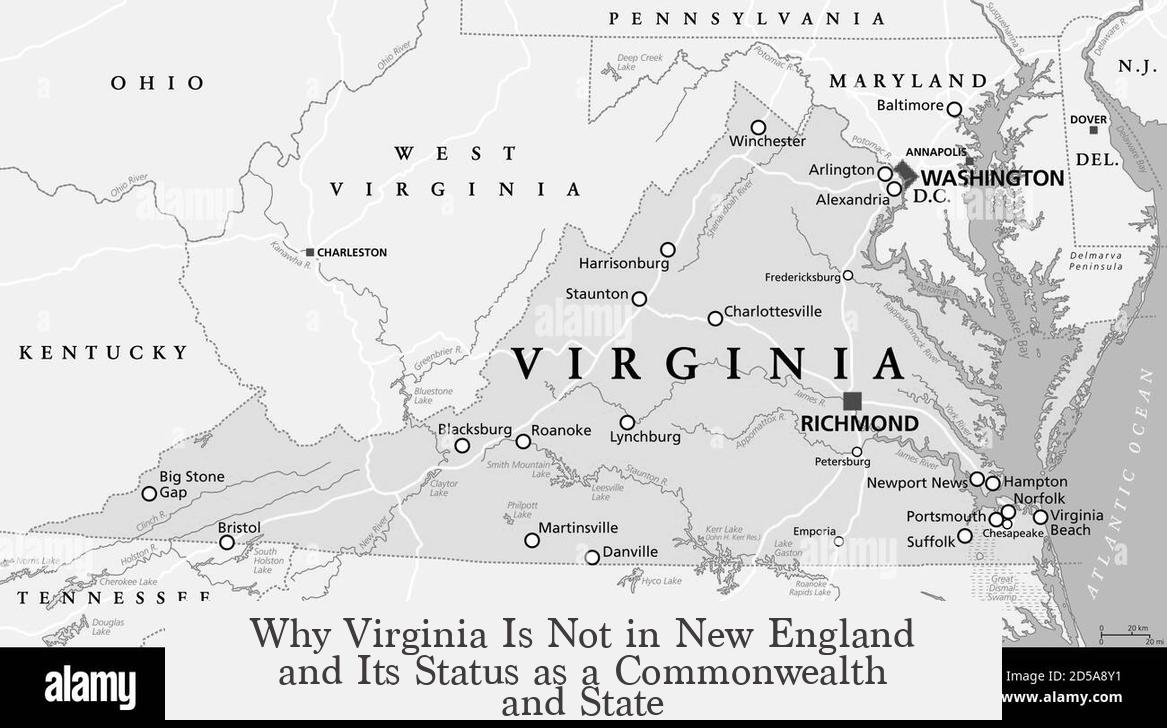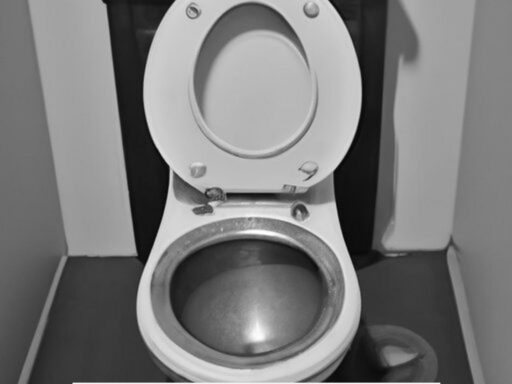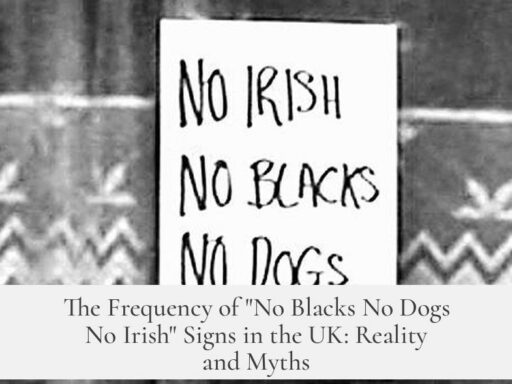Virginia isn’t part of New England because it was established separately under the Virginia Company, which controlled southern areas of English claims in North America, while New England was under the Plymouth branch managing northern territories.
Initially, the Virginia Company had two branches: one in London and one in Plymouth. The London branch managed Virginia and lands to the south. The Plymouth branch governed what became New England to the north. Early settlers and documents, including Captain John Smith’s writings, sometimes used “Virginia” and “New England” interchangeably. However, New England broadly referred to all English-claimed territories in North America, while Virginia specifically designated the southern colony centered around Jamestown.
The designation “New England” was formally recognized by King James I after a petition from colonists. He approved the name and defined New England’s boundaries from approximately 40 to 45 degrees North latitude. This official act reinforced New England as a distinct region separate from Virginia.
Regarding Virginia’s status as both a commonwealth and a state, this reflects historical and political developments rather than a legal difference.
During the English Civil War, the monarchy was replaced by a government known as the Commonwealth of England, symbolizing rule by the people instead of a king. This terminology influenced English colonies in North America, such as Virginia, which adopted the title “Commonwealth of Virginia.” This designation disappeared when the monarchy returned but was revived after the Thirteen Colonies declared independence in 1776.
Massachusetts and Pennsylvania also styled themselves as commonwealths. Later, Kentucky adopted the term as well. Despite the title, commonwealths and states have no legal distinction under U.S. law. Both terms describe the same political entity within the federal system.
| Aspect | Virginia | New England |
|---|---|---|
| Founded By | Virginia Company (London branch) | Virginia Company (Plymouth branch) |
| Geographic Area | Southern North American claims | Northern North American claims |
| Established Name | Virginia (Jamestown) | New England (40–45° latitude) |
| Status Terminology | Commonwealth and state | State |
- Virginia and New England originated under different branches of the Virginia Company.
- King James I officially named the northern colony New England, separating it from Virginia.
- The title “commonwealth” reflects Virginia’s historical ties to republican governance during England’s commonwealth period.
- Commonwealth and state status hold no legal difference in the U.S. judicial system.
Why isn’t Virginia part of New England? And why is it considered both a commonwealth and a state?
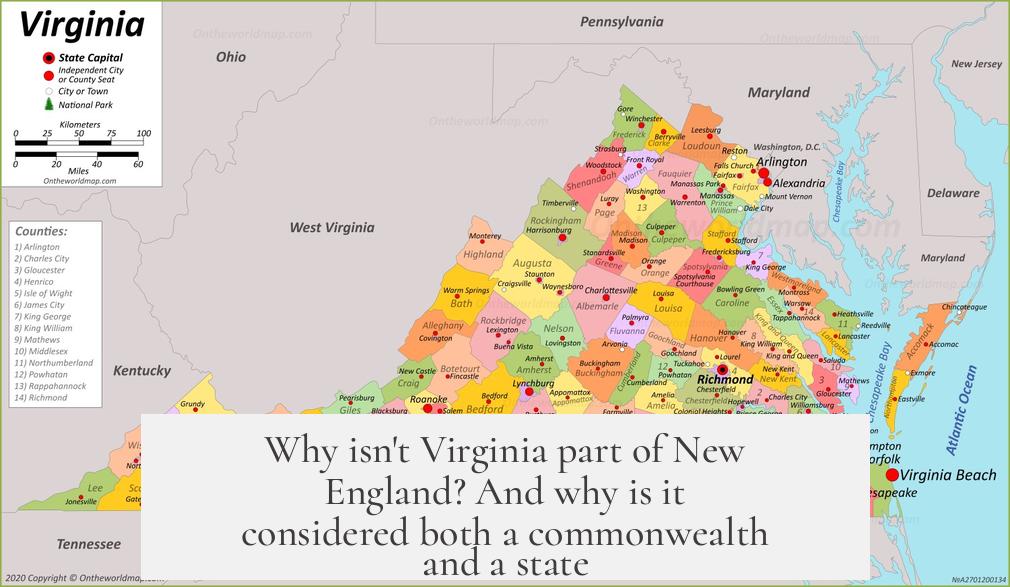
Virginia isn’t part of New England because it was founded under the Virginia Company, which controlled southern lands, while New England was established by a different branch of the same company, overseeing northern territories. Also, Virginia is called a commonwealth due to historical ties to England’s government changes but is legally identical to a state today. Let’s unravel these layers of history and terminology.
Let’s start with the geographical puzzle: Why isn’t Virginia part of New England? It all boils down to how early English colonial ventures were organized. The Virginia Company, which played a pivotal role in English colonization, had two branches—one based in London, the other in Plymouth. Each had authority over different chunks of North America.
The London branch held dominion over the southern lands, including where Jamestown, the first permanent English settlement in North America, was established in 1607. The Plymouth branch, meanwhile, looked after the northern territories, destined eventually to be called New England.
Interestingly, back then the terms Virginia and New England weren’t as crystal-clear as today. Captain John Smith’s writings hinted that “Virginia” and “New England” were nearly synonymous. The distinction was mainly administrative: Virginia referred to lands under the Virginia Company’s management while New England broadly covered English claims further north.
But how did the name New England come about? A 1615 petition to King James I requested that the northern colonists’ territory be officially named “New England,” specifying the latitudinal boundaries roughly between 40° and 45° North. King James I approved this. So New England was not simply an arbitrary label but one sanctioned by royal decree, while “Virginia” stuck to the southern colony founded under the London branch.
This split governance explains why Virginia isn’t one of the New England states. The two regions developed separately, with distinct cultures, economies, and governance structures. Therefore, it’s historically inaccurate to group Virginia into New England. It’s as if two siblings were raised by different families and grew into very different adults.
Why Is Virginia Called a Commonwealth and a State?
Now, about that second mystery: Virginia’s dual identity as both a commonwealth and a state. What’s the deal?
The term “commonwealth” has historical roots in the English Civil War. When King Charles I was overthrown in 1649, England briefly became a republic under Oliver Cromwell, called the “Commonwealth of England.” The word “commonwealth” signaled a government run by the people – a break from monarchic rule.
This style of government philosophy didn’t just vanish across the pond. Some American colonies, immersed in English politics, adopted the term “commonwealth” too, including Virginia. They saw themselves as communities ruled for the public good rather than by kings.
Fast forward to 1776. When the Thirteen Colonies declared independence, Virginia revived the title “Commonwealth” in its official name. Massachusetts and Pennsylvania followed, and Kentucky joined later, keeping up the tradition.
But here’s the kicker: under U.S. federal law, there’s no legal difference between a “commonwealth” and a “state.” Both have the same status and governmental powers. The labels are largely symbolic, emphasizing the state’s focus on governance aimed at the common welfare. The legal system treats “Commonwealth of Virginia” as simply another name for “State of Virginia.” It’s like calling someone “doctor” or “teacher” after their name—respectful styling rather than an official distinction in function.
Virginia’s dual label offers a neat glimpse into the colonial mindset and the influence of English political shifts on American identity. It’s a blend of history and tradition rather than legal complexity.
Wrapping It Up
So, why isn’t Virginia part of New England? Because two branches of the Virginia Company controlled different lands with different colonial charters—southern lands became Virginia, northern lands became New England. The royal approval of “New England” defined it separately from Virginia early on, a separation that stuck through centuries.
And why the “commonwealth” title? Virginia embraces it as a historic nod to republican government ideals from the English Civil War. Yet legally, it remains just another state, identical in power and structure to the rest. Virginia is both a state and a commonwealth—think of it as a historic double badge worn with pride.
Understanding these distinctions uncovers the fascinating tapestry of American colonial history, highlighting how names and governance were shaped by politics and royal decrees, not simply geography. Next time you hear “Virginia” and “New England,” remember—they are relatives but not twins, connected by history yet distinct in identity.
Feeling curious about other states and their unique titles or histories? Dive deeper—there might be more surprises!
